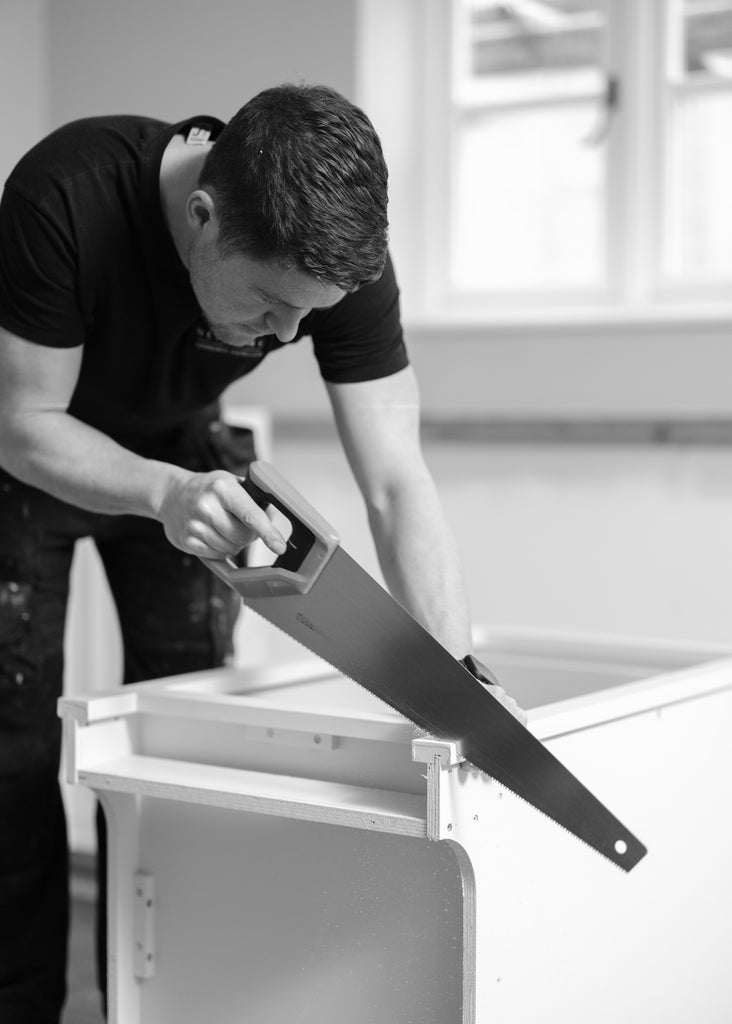Here we answer some frequently-asked questions, and talk you through the unique installation process at Neptune and how our kitchens are designed and fitted to last a lifetime.
What’s the most important thing when it comes to kitchen installation?
The most important thing with any kitchen installation is levelling. No floor is flat, not even in a brand new property, and if a kitchen isn’t levelled, it will affect the structural integrity of the cabinet and the doors and drawers won’t open properly. It’s important that installations are tailored to every kitchen and a good fitter will use a laser line to mark up the room and scribe the cabinets to the floor. When cabinets arrive fully finished and painted, it’s easy to think they look straight and perfect when they’re set out in position. It’s not until the heavy countertop is installed on top that the lack of levelling shows up. Expert fitters will use an electric planer to trim the stiles down and ensure they sit totally flat to the floor, in turn creating a level surface for the worksurface to sit on.
How important is it to use an approved kitchen fitter?
It’s important to make sure that the person fitting your kitchen is properly qualified and that the cabinetry comes with a guarantee that covers you for any faults or adjustments needed in the years to come. Often, in order to warrant a guarantee, you’ll need to have used an accredited fitter. At Neptune, we offer a lifetime guarantee on all of our kitchens but only if they have been installed by an approved fitter. To gain accreditation and reach our exacting standards, our fitters have to have undergone a weeks’ training by our installation experts and designers.


How do the design and materials affect the installation process?
The design and materials used in the construction of a kitchen are really important. At Neptune we make sure the materials we use are solid and not a reconstituted version of its original, such as chipboard or MDF, which are reconstituted timber, formed using formaldehyde and resins. We use ply and solid timber. Ply is stronger, structurally sounder and is resistant to water which is just what you’ll want for a hardwearing kitchen, but also one that is holding the weight of a heavy countertop. The design is also significant so look out for the details in the kitchen cabinetry which should be a box properly built with solid sides, bases and backs rather than a single unit with mechanical adjustments at the base. Most chipboard kitchens are constructed using a chipboard base, chipboard sides and chipboard/hardboard back and rails at the top to hold the sides together. Basically that ‘unit’ is not structurally ‘sound’ until they are screwed together and/or screwed back to a wall. At Neptune we don’t make kitchen ‘units’. We’re true cabinet makers, all our kitchen cabinets have ply sides, base and a solid ply top. We make a proper box, that is structural in its own right before it’s even fitted in the kitchen.


What else affects the quality and longevity of Neptune’s kitchens?
At Neptune we make cabinets that could last a lifetime. Take the door hinges as an example, we use a traditional butt hinge. There is no adjustment to the hinge as it never needs adjusting. The screws that secure the hinge are going into the solid timber frame and are there for the lifetime of the cabinet. Neptune’s painted kitchens are finished by hand using a durable water based eggshell paint. In years to come, should you wish to restyle the kitchen, all it needs is a very light sand, just to key the surface, and the kitchen can be transformed by changing its colour and possibly the knobs and handles.
Click here to explore our kitchen collections further, or if you'd like to book a kitchen design consultation, click here.

